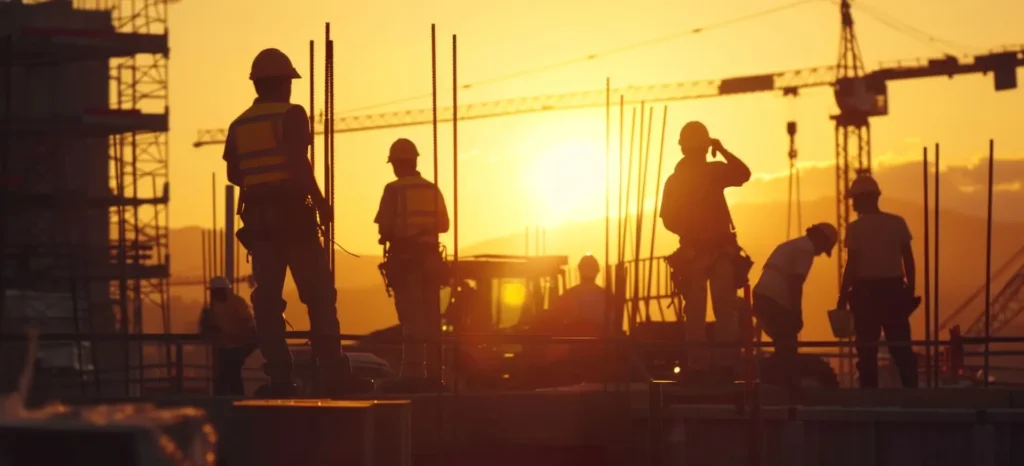The Impact of Weather on Steel Erection Projects
Steel erection is a critical phase in construction, requiring precision and expertise. However, weather conditions can significantly impact these projects, influencing everything from safety to timelines and costs. Understanding these impacts is crucial for planning and executing successful steel erection projects.

How Weather Affects Steel Erection
Temperature Extremes
Both high and low temperatures can pose challenges for steel erection. In extreme heat, steel can expand, leading to issues with alignment and fit. Workers are also at risk of heat-related illnesses, necessitating more breaks and potentially slowing down progress. Conversely, cold weather can cause steel to contract and become brittle, increasing the risk of fractures during handling and erection. According to the Occupational Safety and Health Administration (OSHA), extreme cold can also pose hazards to workers, such as frostbite and hypothermia (OSHA).
Wind
Wind is a significant concern for steel erection projects, particularly when working at height. Strong winds can make it difficult to safely lift and position steel components. Wind speeds above certain thresholds can halt crane operations and other lifting activities. The National Institute for Occupational Safety and Health (NIOSH) recommends that steel erection should not proceed if wind speeds exceed 30 mph (NIOSH).
Precipitation
Rain, snow, and ice can all impact steel erection. Rain can make surfaces slippery, increasing the risk of slips and falls. Snow and ice can accumulate on steel components, making them difficult to handle and connect. Additionally, moisture can lead to rust and corrosion if protective coatings are not adequately applied. Wet conditions also pose electrical hazards, especially when welding (“Impact of Rain on Construction Projects”).
Humidity
High humidity levels can exacerbate corrosion issues and affect the curing times for certain coatings and adhesives used in steel erection. Humidity can also impact the comfort and safety of workers, leading to dehydration and heat exhaustion in hot, humid conditions.
Mitigation Strategies
To mitigate the impact of weather on steel erection projects, several strategies can be employed:
Weather Monitoring and Planning
Regularly monitoring weather forecasts and having contingency plans in place is essential. This allows project managers to adjust schedules, allocate resources, and implement safety measures proactively.
Protective Equipment and Clothing
Ensuring workers have appropriate protective clothing and equipment for various weather conditions can help maintain safety and productivity. This includes thermal gear for cold weather, hydration stations for hot conditions, and rain gear for wet environments.
Temporary Shelters and Windbreaks
Using temporary shelters and windbreaks can provide protection for workers and materials, reducing the impact of adverse weather conditions. Enclosed spaces for welding and other sensitive operations can help maintain quality and safety.
Scheduling Flexibility
Building flexibility into project schedules allows for adjustments based on weather conditions. This can include planning for potential delays and having backup plans for critical tasks that cannot be performed in adverse weather.
Enhanced Training and Safety Protocols
Providing training on weather-related safety protocols and emergency procedures ensures that workers are prepared to handle unexpected weather changes. Regular safety drills and briefings can reinforce these protocols.
Case Studies
Several steel erection projects have successfully navigated weather-related challenges by implementing these strategies. For example, the construction of the One World Trade Center in New York City involved extensive weather monitoring and planning to manage the impacts of wind and cold temperatures (“One World Trade Center”). Similarly, the development of the Burj Khalifa in Dubai required careful consideration of extreme heat and humidity to ensure the safety and efficiency of the steel erection process (“Burj Khalifa”).
Conclusion
Weather conditions play a crucial role in the planning and execution of steel erection projects. By understanding the potential impacts and implementing proactive strategies, project managers can mitigate risks, ensure safety, and maintain project timelines and budgets. As climate patterns continue to change, staying informed and adaptable will be key to the continued success of steel erection projects.
Works Cited:
“Cold Stress.” Occupational Safety and Health Administration, www.osha.gov/cold-stress.
“Wind Hazards in Construction.” National Institute for Occupational Safety and Health, www.cdc.gov/niosh/topics/wind/default.html.
“Impact of Rain on Construction Projects.” Construction Executive, www.constructionexec.com/article/impact-of-rain-on-construction-projects.
“Welding Safety in Wet Conditions.” Occupational Safety and Health Administration, www.osha.gov/sites/default/files/publications/OSHA_FS-3647.pdf.
“One World Trade Center.” Architectural Digest, www.architecturaldigest.com/story/one-world-trade-center.
“Burj Khalifa Construction.” Designing Buildings Wiki, www.designingbuildings.co.uk/wiki/Burj_Khalifa.